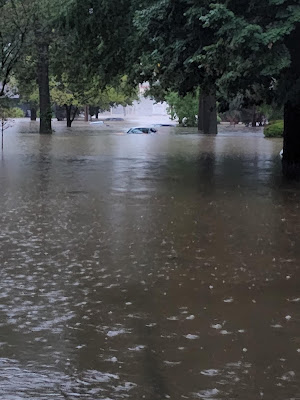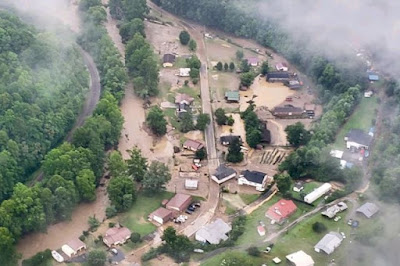 |
| In a photo posted on Twitter by @ShawnRichards, a 98-woman is trapped in her flooded Kentucky home. She was later rescued and is now reported to be safe. |
There was one pic on social media showing a 98 year old woman trying to balance on a chair floating in three feet of water inside her Kentucky home. (She was later rescued and was reported to be safe).
Or a road that once had a row of house. The houses are gone now, leaving behind a couple concrete slabs. What happened to the people in those houses?
The flash flood hit in the middle of the night. Eight inches of rain poured down on steep terrain already waterlogged by repeated rounds of thunderstorms in the past month. This was the second 1 in 1,000 year flood to hit a part of the United States within a week. (St. Louis was hit a couple days earlier).
The timing of this cataclysmic flood could not have been worse. It was the middle of the night. Maybe the sound of the initial downpours roaring on the roofs that evening lulled people into a relaxing sleep. They certainly weren't ready to hear the flash flood warnings. Plus, the water came so fast, who could react in time?
Walls of water and mud poured off the slopes in the darkness. Victims awoke to the sound of rushing water and debris flowing into their homes, or making their homes float away while they were inside. It had to be beyond terrifying. You couldn't see in the darkness, you couldn't find your loved ones as the cold water and debris battered their houses, and their bodies.
That hundreds of people have been rescued is in itself a miracle. And a testament to the bravery of Kentuckians who went out on this rescue missions.
The Kentucky disaster affected me more than most of the other stream of climate related disasters we've had this year, and in the past few. Yes, this one was probably climate driven. Heavy rain storms are now heavier under a climate change regime. What might have been a problematic flash flood a few decades ago was catastrophic now.
First of all, it's not like Kentucky needed another storm crisis.
As the New York Times reports in this run on sentence:
"'I wish I could tell you why we keep getting hit here in Kentucky,' Gov Andy Beshear said during a briefing in which he updated residents on the rising death toll and displayed a sense of anguish and exhaustion that many in the state have felt after recurring disasters, including a powerful ice storm last year that cut off power to 150,000 people in eastern Kentucky, a flash flood last July that left many stranded in their homes and a rare December tornado that carved a nearly 200-mile path of destruction that killed 80 people."
The other disasters, and this week's flood in particular, hit people that have even fewer resources to deal with kind of thing that most people.
An irony of the Kentucky flood is it hit coal country. But the coal industry is now greatly diminished, as the world works toward finding other sources of energy other than things like coal, which contribute greatly to climate change.
This declining coal industry left Appalachia, including the flood zone, even more impoverished than it was before. Which means the people suffering most from this disaster the fewest means to recover from it
And no, before you leap to conclusions, I'm not blaming the former coal miners and their families for the flash flood that just ruined their lives. They are innocent in this whole thing.
This terrible flood hit kind of close to home for me, too. I grew up in Vermont, which at first glance cannot seem more different than the hollows of eastern Kentucky.
You can see in the news footage that this flood did not hit the kind of quaint, prosperous and pretty villages Vermont is famous for. The disaster zone was pretty gritty even before the first drops of rain fell last week.
But there really are a lot of similarities between Vermont and eastern Kentucky. I grew up in West Rutland, Vermont. Don't get me wrong, West Rutland is a wonderful small town. But it's not touristy Woodstock or Stowe. It's decidedly working class. People in West Rutland don't have million dollar bank accounts handy to recover from setbacks.
And it's surrounded by steep mountains. There's also a lot of winding back, gravel roads and blacktop rural lanes that wind up and down these hills. Modest houses, many more than you'd think, are hidden in these woods. I just pictured the same storm that hit Kentucky roaring through West Rutland and environs. And shuddered.
Most other areas of Vermont, away from the tourist destinations, are very much like West Rutland.
We're certainly not immune from these terrible flash floods. Vermont has essentially the same terrain as eastern Kentucky. It's easy for heavy rains to prompt terrible flash floods and we certainly have a history of those. November, 1927. September, 1938. June, 1973. August, 1995. July, 1997. June, 1998. the spring floods of 2011. Tropical Storm Irene, August, 2011.
Those floods all caused tremendous damage in Vermont, and some of them resulted in deaths. There's videos on YouTube of serious Irene flooding in West Rutland.
But climate change ups the ante. It could even possibly be much worse than that video taken from a truck splashing through 2011 West Rutland flood waters. The Kentucky flood was "impossible" until it happened. Other impossible extremes are also happening. Will the impossible happen in Vermont? I really don't know.
My mother died in May, and now the West Rutland house where she lived and where I grew up in is up for sale. A nice young couple is interested in buying it. The house isn't near any creeks or streams. It's on a hill, not a flood plain. I don't recall it ever suffering any kind of flood damage.
But the stakes are now higher. If this couple buys the house, I don't think they'll ever have to deal with flooding. If they buy, I hope the enjoy the place for many, many years.
But suddenly, I no longer am that sure that house will survive a climate disaster. Or my house in St. Albans, Vermont. Or anybody else's house for that matter.
It's not that I stay up all night worrying about it. But that thought is in the back of my head. And if we're honest, it's in the back of many people's heads. It probably was for some of the flood victims in Kentucky, and then the nightmare became a reality.
The chances of an "impossible" weather calamity hitting any individual is low. But unlike in past decades, the impossible is now possible. As Kentucky and St. Louis demonstrated last week.























